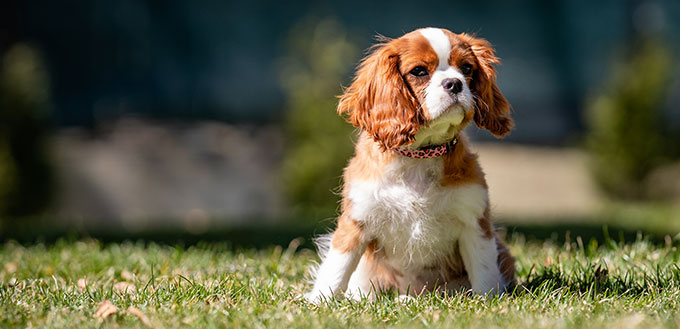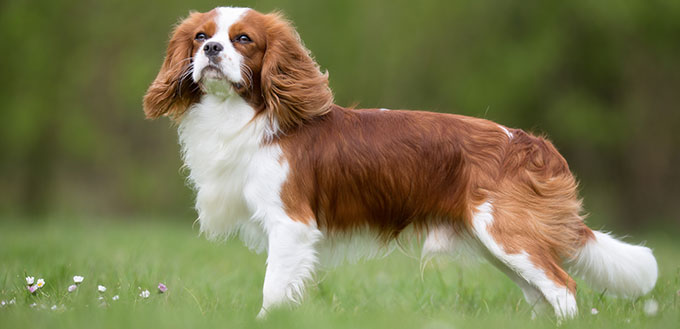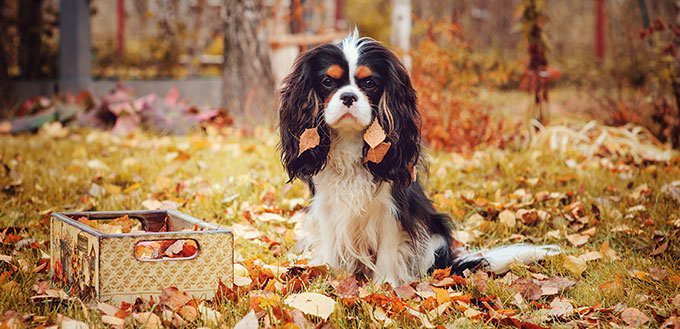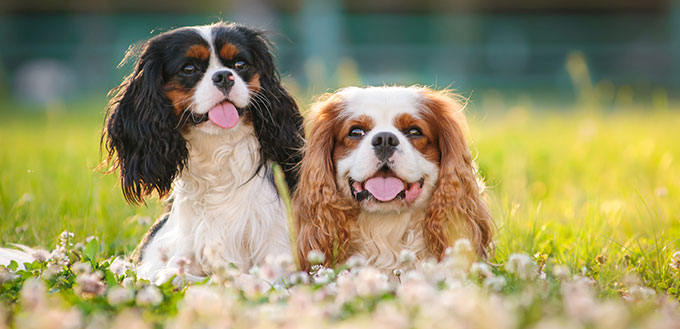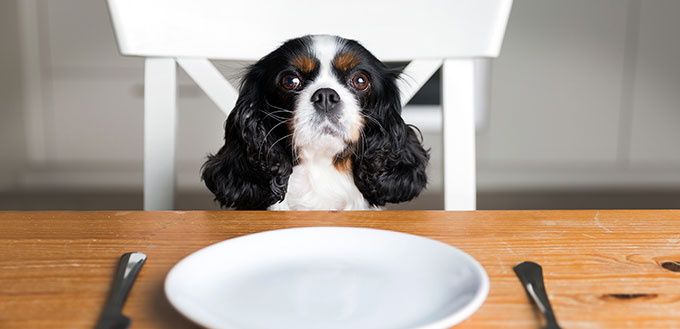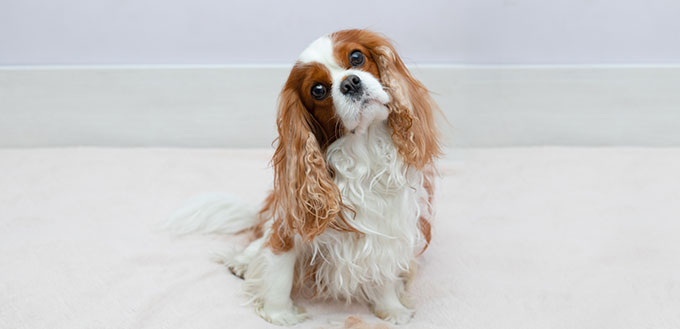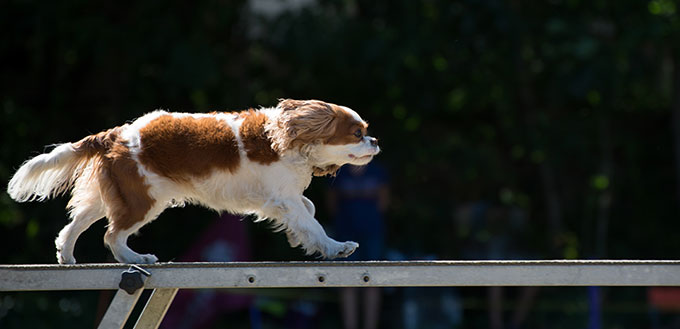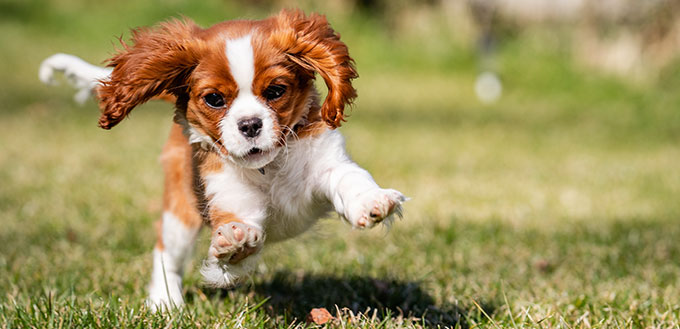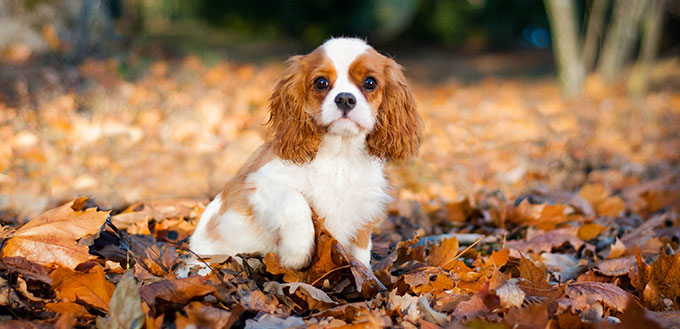Cavalier King Charles Spaniel dogs are one of the larger of the toy breeds, and even though they may have been bred as companions, they have also retained a lot of the sporting instinct found in their Spaniel ancestors. This means they are just as happy going on a hike and training agility as they are curled up on your lap. They are a regal, gentle, and classic breed with a rich ancestry steeped in royalty and noblemen, and were barely rescued from extinction in the early 20th century.
If you’re lucky enough to own one of these stunning dogs, knowing everything there is to know about them will give you the ability to prepare a perfect life for your new pup. Fortunately, we have compiled all of the essential dog breed information you could need to do just that.
Breed Overview
| Dog Breed Group | Height | Height | Life Expectancy | Energy Level |
|---|---|---|---|---|
| Companion Dog | 12 to 13 inches | 13 to 18 pounds | 9 to 15 years | Average |
History of the Cavalier King Charles
Cavalier King Charles Spaniels are a toy breed that rose to fame in 1661 with the “Merry Monarch” known as King Charles II of England. King Charles was a prolific dog breeder and often surrounded himself with a small pack of spaniels that adored him, and he them. These spaniels would accompany him absolutely everywhere, including the Houses of Parliament as well as joining him in bed at the end of a long day. King Charles II was also known by the nickname “The Cavalier King” hence the beginning part of their name and his adoration for this particular breed made them incredibly popular throughout the country, especially among noblemen, as royalty set trends and expectations for clothes, pets, and lifestyle for the higher classes.
The English Toy Spaniels of this time were depicted in many paintings by famous artists such as Van Dyck and Gainsborough, these Spaniels had slightly different physical characteristics to the spaniels of today, such as high set ears, flat heads, and longer noses.
When King Charles II died in 1685 the King Charles Spaniel dog breed began to lose popularity in favor of other dog breeds such as the Pug and Japanese Chin. as a result of this crossbreeding the well-known English Toy Spaniel, from which the modern-day Cavalier King Charles Spaniel originated, had changed quite dramatically by the 1800s; It had adopted the flat facial features of the pug and developed a much shorter muzzle and more domed skull. Effectively the long-muzzled red and white English Toy Spaniels from the days of Charles II had all but disappeared.
1928 was the year in which the Spaniels of King Charles II’s reign were barely rescued from extinction, thanks to the efforts of Roswell Eldridge who, since 1923, had been offering 25 pounds sterling in the Crufts dog show for any Spaniel that matched the description provided by the old paintings. Eventually, Miss Mostyn Walker presented a dog named Anne’s Son for evaluation and received the £25 prize, though unfortunately, Eldridge didn’t get to see the prize being claimed as he had passed away a month before the dog was presented.
His efforts, however, had revived interest in the breed resulting in the forming the Cavalier King Charles Spaniel Club, so named to differentiate this particular breed from the flat-faced King Charles Spaniel recognized by the Kennel Club (now known as the English Toy Spaniel in the United States). This club held its first meeting the day after Crufts and spent that time developing the new breed standard using Ann’s Son as an example. They then fought for recognition for 17 years, until the Kennel Club finally conceded and officially recognized the breed as the Cavalier King Charles Spaniel (a breed of its own).
Cavaliers were introduced into the United States from England in the 1940s, but it wasn’t until 1952 that Cavaliers began their ascent into popularity. A woman in Kentucky by the name of Mrs. Sally Lyons Brown was given a black and tan Bitch named Psyche by her English friend Lady Mary Forwood, Mrs. Lyons Brown fell in love with her new dog and began to import more and more Cavaliers into the States.
Upon realizing she was unable to register her Cavaliers with the American Kennel Club, Mrs. Lyons Brown decided to contact other Cavalier owners throughout the United States, totaling less than a dozen, and in 1954 founded the Cavalier King Charles Spaniel Club, USA (CKCSC, USA). This club is now the only registering body for Cavaliers in the United States and has been for over 50 years.
A Few More Words About the Cavalier King Charles Spaniel
Presently the members of the CKCSC, USA have decided against pushing the American Kennel Club to change the breed’s registration status and give them full recognition, as they fear that too much popularity will result in commercial breeding, further results in a loss of the breed standards established during the club’s conception.
Cavaliers are described as being an utterly heartwarming breed, with big round dark eyes and a tail that wags happily with every movement, their sweet expression companionship and is enough to make anybody feel a bit happier. They are a gregarious breed that adores the company of others and are ideally suited to somebody who is going to be with them all day. Companion dogs don’t only make good companions but need good companions, and many often find that a Cavalier and its owner grow to need each other for comfort.
Breed Highlights
- Cavaliers are not bred to be outdoor dogs and should always be kept inside.
- Their spaniel nature can give them a tendency to chase cats, birds, and other small animals, so they must be kept in a property with a secure garden.
- Cavaliers have a high risk of developing genetic diseases if bred improperly, and so a reputable breeder is essential for a healthy pup.
- They are far too friendly to be used as guard dogs, even though they have been known to bark when people pass the property.
- Their fur required plenty of brushing, especially the long hair on their ears.
- The Cavalier King Charles Spaniel dog breed is one of the few breeds used as therapy dogs, owing to their kind-hearted nature and companion dog history.
Cavalier King Charles Dog Breed Appearance
The general appearance of a Cavalier King Charles Spaniel, as described by the American Kennel Club Breed Standard documentation is “The Cavalier King Charles Spaniel is an active, graceful, well-balanced toy spaniel, very gay and free in action; fearless and sporting in character, yet at the same time gentle and affectionate. It is this typical gay temperament, combined with true elegance and royal appearance which are of paramount importance in the breed. Natural appearance with no trimming, sculpting or artificial alteration is essential to breed type.”
There are a few color variations of the Cavalier King Charles Spaniel Dog, but aside from that, they have a rather specific list of features that they need to fit into to be considered a “true” King Charles Spaniel. Below we have put together a few tables to easily break down the aesthetic expectations of a Cavalier King Charles, as decided by the AKC.
Size
Cavalier King Charles are considered to be a small breed. Their height is generally between 15 and 16 and a half inches, with a body length of around 19 to 20 inches. Because they are not overly muscular dogs their weight is quite average sitting around 13 to 18 pounds, however, these measurements can vary slightly depending on the gender of the hound in question.
Coat
Cavalier King Charles Spaniels have a smooth coat that is very soft in texture, they are double-coated with a downy undercoat and silky topcoat which can help protect them in various weather conditions. Their fur is of moderate length with a slight wave, this wave is most prominent on their ears where the fur is longest, that and their tails.
Cavalier King Charles Dogs have 4 different main color combinations that are expected by the AKC, these four colors are named as such; Ruby (mahogany), Prince Charles (tri-color black, tan, and white), King Charles (black and tan), and Blenheim (chestnut and white). each color has a specific pattern which is expected:
- Blenheim: Chestnut markings broken up over white. Chestnut ears and eyes, evenly spaced and clearly separated with a white blaze between the eyes.
- Tri-color: Jet black markings over a white ground. Black ears and eyes, evenly spaced and clearly separated with a white blaze between the eyes, with chestnut markings over the eyes, along the cheeks, inside the ears, and on the underside of the tail.
- Ruby: Entire body a rich mahogany color.
- Black and Tan: Jet black, with bright tan markings over the cheeks, eyes, chest, legs, inside of the ears, and on the underside of the tail.
General Size and Build
Cavalier King Charles has a short-coupled body that tends to taper slightly towards the back, they are moderately muscular for their size, and are generally very fit, and you should expect to see them with laid-back shoulders, a level tail, and elbows quite close to their body.
When looking at the face of a Cavalier King Charles Spaniel, they should always have a sweet, gentle, and approachable expression with heart-melting large, round, soulful, dark brown eyes. Their heads are always proportionate to the rest of the body and their big floppy ears should brush their shoulders, giving them the appearance of a dog with an excellent haircut!
Interesting Cavalier King Charles Facts
- This breed got its name from King Charles II as he couldn’t be seen without one. (King Charles was also nicknamed the Cavalier King, giving them the first part of their name)
- King Charles II decreed that Cavalier Spaniels could not be denied access to anywhere, including the Houses of Parliament.
- When King Charles II died, pugs became the new favored breed of royalty, pugs were then mated with Cavalier Spaniels, giving them the look they have today.
- They were used to attracts fleas away from their owners at nighttime, by having their dog in the bed with them.
- There are 4 colors of Cavalier, each with its own name; the King Charles (black and tan), Prince Charles (tri-color), Blenheim (chestnut and white), and Ruby (mahogany).
- Modern Cavaliers have been bred from the English Toy Spaniels.
- In 1985, President Ronald Reagan presented a Cavalier named Rex to his wife.
The Cavalier King Charles Personality
As you would expect from a companion dog bred by royalty, the Cavalier King Charles is dignified, dainty, and kind. They are also one of the more personable dog breeds, with welcoming and cheery personalities, so you can expect that anyone that comes to visit your home is going to fall in love with them in no time at all.
They are not particularly high maintenance when it comes to keeping them happy, so long as they have their owner by their side they won’t become overly fussy, but it is worth noting that because they rely so heavily on the company of others they should not be left alone for long periods of time as this can cause separation anxiety.
Temperament
Cavalier King Charles spaniel dog, which like its Cocker Spaniel cousin, is extremely friendly not only with other animals but with humans as well. They always display an eagerness to meet and please new friends and are usually successful in this endeavor with a few happy swishes of their fluffy tails. They are not known to be remotely aggressive, in fact, they are extremely sweet, gentle, and have an exceptional amount of patience, all a Cavalier King Charles really wants is a good cuddle and plenty of attention from it’s family; the more bustling the household, the better.
Like all dogs, however, the Cavalier King Charles Spaniel is no different in the way that it can become quite rambunctious when it gets excited, and even though they are not known to bark, it comes down to the personality of the individual dog. They have been known in some cases to bark when strangers approach the property, though this would not be grounds to use one of the Watchdog as it is not promised behavior. They are first and foremost a loving companion, not a working dog.
Around Children
Because of his extremely kind nature, great patience, and playful friendliness, the Cavalier King Charles dog breed is known to be great around children and make brilliant family dogs. Seeing as it is a companion dog, it is able to have handlers as young as 12 years old. Though much younger children should always be supervised around any dog breed because young children have a tendency to be more heavy-handed and therefore run the risk of mishandling a dog unintentionally.
Around Other Animals
Generally, the Cavalier King Charles is great with other animals if they are being introduced to a home with other pets, owing to the fact that they are friend-makers. However, submissive and gentle as they may seem, Cavalier King Charles Spaniels are still Spaniels, and so they can have a tendency to chase smaller animals as is their instinct; this is something to bear in mind if you are considering a Cavalier for a house with cats.
This is also worth noting when taking your cavalier out for a walk; if let off the lead you may find that your new pup becomes distracted by the local wildlife and may wander off if not watched closely.
Entertainment
Cavaliers are a very intelligent breed, therefore they require plenty of mental stimulation to keep them from getting too bored. they may enjoy a good cuddle and the company of their humans, however, additional entertainment is well worth the investment, as this will also encourage them to become less dependent, and help them to avoid separation anxiety issues.
The following forms of entertainment are recommended for a dog like the Cavalier King Charles:
- Puzzle toys
- Learning tricks
- Playing fetch
- Going for a walk
- Training
For all of their calm personality traits, it can be easy to forget that Cavaliers are descendants of a sporting breed, meaning entertainment and exercise are both essential for their mental well-being.
Quick Personality Facts
- Cavaliers are prone to separation anxiety if left alone for a long period of time.
- They are a cuddly breed that loves to curl up on your lap and go to sleep.
- Cavaliers can be quite boisterous and are extremely friendly.
- They love to meet new people and animals and are extremely eager to please.
- They do best when put with another Cavalier as a constant companion for when the human isn’t available.
- Cavaliers are gentle and playful making them ideal family pets.
- They are not big barkers, generally speaking, and would not make good watchdogs.
Cavalier King Charles Spaniel Care
Caring for a King Charles Cavalier Spaniel is not unlike caring for any other dog, in that they require plenty of exercise, training, and a wealth of love and affection. However, knowing the typical traits and characteristics of the breed can help you to tailor your care to your new pooch. King Cavalier Spaniel is intelligent, responsive, delicate, and loving, and deserves the very best when it comes to training, feeding, grooming, and interaction.
Training
From the day you first bring home your King Charles Spaniel puppy, you will need to begin training, to make full use of their young receptive mind and intelligence. Because Cavaliers are so eager to please they are extremely easy to train; they will listen well and do their best to interpret your instructions in a way that makes you happy. Cavaliers are also particularly adept at learning canine sports such as agility, rally, and obedience, this is because they are descended from a sporting breed and still carry that competitive instinct.
Potty Training
Potty training a Cavalier King Charles Spaniel puppy is actually a little bit easier than you might expect, though potty training isn’t exactly a doddle, they will always try their best to do as you have instructed even if they don’t always understand.
The key thing to remember when potty training a puppy is that it is absolutely vital that you avoid punishing them when they have an accident, and instead use positive reinforcement when they go in the correct place. This is because when you punish a puppy for having an accident they begin to have negative associations with the act of going to the toilet, and as a result, may hold it in for as long as they can and end up having an accident when they’re incapable of holding it any longer.
Obedience Training
Because of their people-pleasing nature, the Cavalier King Charles Spaniel dog breed does not often require a lot of obedience training. They will naturally respond to their owner and do not have any stubborn or hard-headed tendencies when it comes to training sessions. Of course, this is entirely dependent on the personality of the dog you are training, as any dog can be stubborn just as much as any dog can be completely receptive.
The one thing to consider may be that if you have chosen to adopt a full-grown Cavalier King Charles Spaniel, they may require obedience training if they have previously experienced abuse or neglect. This is not because they are necessarily disobedient, but because obedience training can help you to develop a bond with your dog as well as encouraging them to trust you.
Work
The Cavalier King Charles dog breed is not suited to manual labor such as Farm work, though they do still possess the sniffer dog instinct which can drive them to behave in a similar way to a hunting dog at times.
Ideally, a Cavalier King Charles Spaniel should work as a therapy or companion dog, providing comfort and companionship to those in need of it. King Charles Spaniels are often found in senior citizen homes as a means of fellowship And support and are very effective in such work. They are also often used as therapy dogs to help those with psychological disorders that may struggle in social situations as something to seek solace in, and an anchor.
Feeding
Cavalier King Charles Spaniel always be on high-quality food which can cater to the delicate digestive system. There is a range of diets that can suit a Cavalier King Charles Spaniel, so long as you’re careful to follow the recommended amounts as provided by the food manufacturer.
Please keep in mind when you are looking for the right food for your Cavalier, that they are a dog breed that has been known to gain weight easily if their food intake is not monitored properly.
Raw Dog Food
Probably the least likely of the 3 diet options to be used for a Cavalier King Charles Spaniel, but no less beneficial and enjoyable for them, is the raw food diet. Many may not consider the raw food diet as one you would give a small breed like a Cavalier King Charles, however, it provides a rich amount of protein, natural carbohydrates, calcium, and fat required for a balanced diet.
This completely natural diet caters to a deep-rooted instinct in every canine, however, it is also more costly and should be calculated carefully if considered as a full-time diet.
Biscuits / Dry Kibble
Dry kibble and biscuits are a classic choice of diet for most dog owners, as it can cater to a wide budget range whilst providing your pooch with all of the necessary nutrients and minerals they will need to fuel them for the day.
The main thing to consider if then you are thinking of using dry kibble for your Cavalier King Charles Spaniel is the quality of the food you are purchasing; some dry kibble brands use unnecessary fillers which provide no nutritional benefit for a dog, and so we would highly recommend that you research carefully any kibble you are thinking of buying before settling on it.
You May Also Like: Dry Dog Food
Wet Dog Food
Wet dog food can seem like the perfect choice, providing soft meat without the worry of raw contaminants along with rich flavor, and can be absolutely perfect for your pooch so long as you take certain things into account; wet food does not provide a crunchy element to your dog’s diet which can mean that your Cavalier will have a higher chance of developing dental problems, so be sure to provide them with plenty of dental chew toys and try to brush their teeth once a day if possible.
Wet food can also be quite high in fat and sometimes sugar, seeing as King Charles Spaniels have been known to gain weight quite easily you have to be vigilant when monitoring how much they are eating of this irresistible food.
Grooming
If you are raising your Cavalier King Charles right, you will not need to cut or alter their hair in any way. This makes grooming them far simpler, as all you need to do is make sure that you have got a good grooming brush handy, along with a couple of decent de-shedding products such as de-shedding shampoos and conditioners to properly take care of their silky coat.
Managing Shedding
Cavaliers are not excessive shedders and so long as you are sure to groom them daily with a good brush you should be able to keep on top of their hair loss. The main areas to focus on are the ears and tail where the fur grows the longest because as they shed long fur has a much higher chance of becoming matted which can be far more difficult to correct. Fortunately, because they are only little dogs, brushing a Cavalier will only take a few minutes.
Health Issues
Cavaliers have a healthy estimated life span of 12 to 15 years, however, like any dog, they are susceptible to several illnesses throughout that life span it can affect them in various ways. Fortunately, the Cavalier King Charles is not predisposed to as many health problems as some other breeds, and there is every possibility that your Cavalier could live its entire life having not been affected by a single one of them.
Knowing the health issues that could potentially affect your pup can at least provide you with the foreknowledge that could help you to notice any early-onset symptoms and lead you to treatment.
- Hip Dysplasia: Hip dysplasia affects the way that the hip bone fits into the hip joint. It is a hereditary condition that can be triggered by the environment, genetics, diet, or even trauma. There are treatments available for Hip Dysplasia, and in more severe cases surgery can be done to correct the problem. Typically Hip Dysplasia causes lameness and can lead to an inability to walk altogether.
- Mitral Valve Disease (MVD): Mitral Valve Disease is one of the more common health conditions to affect Cavaliers, and can lead to heart failure. It is the result of a heart murmur that becomes increasingly worse over time and can affect Cavaliers from as young as one or two years old. Heart problems are believed to be a genetic weakness, meaning breeders are doing their best to try and weed out this heart disease in future generations by only breeding those which have been assessed by a cardiologist. There is ongoing research in regards to the prevention of this condition, however, so far there is no known cure.
- Syringomyelia (SM): Syringomyelia is also one of the more common health conditions seen in Cavaliers, and affects the spine and brain. The symptoms of Syringomyelia can be anywhere from mild discomfort, to experiencing partial paralysis and severe ear pain. It is a condition caused by malformation of the skull, meaning that the space for the brain is reduced, and the symptoms of this condition can begin to show between the ages of 6 months and 4 years. The symptoms you can expect to see are; the dog whimpering, seeming sensitive around the head, neck, or shoulders, and doing something known as “air scratching” in which they appear to be scratching at the area around the neck and shoulders without making contact (this is often done on one side of the body). If you notice that your Cavalier seems to be scratching more than normal, or displaying any of the above symptoms it is worth taking them straight to your veterinarian for an evaluation.
- Episodic Falling: A condition often confused with Epilepsy, Episodic Falling is defined by the dog having a seizure or falling to the ground whilst still conscious, and is caused by the dog being unable to relax its muscles. This can vary between lasting for a few minutes to several hours and is more often seen in senior dogs, though symptoms can start to show as early as 5 months.
- Keratoconjunctivitis Sicca (Dry Eye): Another of the more common health conditions that are easily treatable with daily eye drops, it is caused by an autoimmune reaction to the dog’s tear glands and results in the reduction of tears. If this condition is left untreated, it can eventually lead to blindness.
Exercising
The Cavalier King Charles Spaniel dog breed exercise requirements are a little bit more exercise than you might think, they may only be small however they do descend from a sporting breed, and, as you may be aware, other spaniels such as the Cocker Spaniel are known for being extremely hyperactive and in need of constant exercise. Fortunately, the Cavalier King Charles is not quite so demanding, however, they do require a good long walk each day to keep them happy.
King Charles Spaniels also do well with canines sporting activities and more heavy-duty exercises such as the following:
- Playing tug-of-war
- Hiking or jogging
- Agility training courses
- Racing sports
- Biking or skating
- Dog Sports
They may be small but they are fast, and determined, and may surprise you.
Adopt Don’t Shop
Unfortunately, as easygoing and absolutely stunning as the Cavalier King Charles Spaniel is, they are still given up to rescues and shelters for various reasons, the most common reason being expense when it comes to medical care, though they are also given up for the simple fact that their owner is unable to care for them anymore, or because that particular Cavalier’s personality may not suit them. No dog deserves to go without a home, however, and you could get yourself a Cavalier King Charles for a fraction of the price, meaning you’ll have more money to put towards spoiling them on arrival!
Cavalier King Charles Rescues
Deciding to adopt a Cavalier King Charles Spaniel can give a dog a perfect loving home that is willing to show them patience and care. When looking at where to adopt from, you would be pleased to know that there is a plethora of Cavalier King Charles Rescues that have dedicated themselves to the rehabilitation and rehoming of this fantastic Spaniel breed.
Be sure to remember that when you are selecting your pup, ask the rescue group about their history and any health problems they may have so that you can go into the adoption fully informed, and provide them with the best home possible.
- Cavalier Rescue USA: Adopting all over the United States.
- Bliss Cavalier Rescue: Adopting throughout the United States with the use of widespread foster homes.
- Lucky Star Cavalier Rescue: Adopting throughout the United States and Canada.
- The American Cavalier King Charles Spaniel Rescue Trust (ACKCSC): Adopting throughout the United States.
These are just a few of the incredible Cavalier King Charles rescue groups throughout the USA, compiling an epic rescue network that can help you to rehome one of the beautiful dogs. Every Cavalier rescue is dedicated to providing their dogs with the perfect forever home, you could be just that.
Reputable Breeders
When on the search for a reputable breeder, your best chance would be to approach the American Kennel Club marketplace. The AKC thoroughly checks and screens each breeder before recommending them to the public via their Marketplace, and so you can be sure that if you were to purchase a puppy from one of these breeders they will be the best you can get.
Furthermore, you can also approach your veterinarian or any Cavalier King Charles Spaniel breed clubs you may know of for a referral to a good breeder. Professionals and lovers of the breed will only recommend humane breeders of good quality.
Price
When it comes to getting a Cavalier King Charles puppy, you have the option of adoption or purchase. If you choose to adopt a Cavalier King Charles Spaniel you’ll be looking at an adoption price of around $200-300. If the adopted puppy or dog has had to undergo medical treatment, however, there is a possibility of this cost being heightened to around $700.
Should you decide to go with a puppy breeder, (make sure it is a reputable one as there are many puppy mills out there that produce large amounts of Cavalier King Charles puppies via inbreeding and mistreatment) the cost can vary between $1,800 and $3,500. The breeder price of a Cavalier King Charles is entirely dependent on its genetic line, a purer breed will inevitably be much more expensive.
Additional Expenses
There are also additional monthly, or lifetime expenses that must be considered when you are thinking of buying any dog.
- Monthly food cost
- Food and water bowls
- A collar and ID tag
- Toys and training equipment
- A crate (if wanted)
- Microchipping
- Pet health insurance
- Medical care
- Grooming
- Treats
FAQ’s:
Q: Is a King Charles Spaniel a good family dog?
A: Not told me your cavalier King Charles Spaniels considered fantastic family dogs, but they are also considered to be great dogs for senior citizens, because of their gentle and quiet nature, friendliness, and lack of aggression. Like any dog, the main thing to consider if you are thinking of getting a King Charles spaniel is that they should not be left alone with young children, as there is a possibility of them being mishandled.
Q: Do Cavalier King Charles spaniels bark a lot?
A: Generally, the Cavalier King Charles breed is not considered a loud particularly talkative dog, however, they are known to struggle with separation anxiety and so they can bark if left alone for too long. They can bark if they are particularly bored or experiencing stress, anxiety, or pain, though barking is largely down to the individual personality.
Q: Can a Cavalier King Charles Spaniel be a service dog?
A: Cavalier King Charles Spaniels are considered one of the best dog breeds to be a therapy service dog, this is because this particular breed was originally developed as a companion to Kings and royalty, hence the name. During the breeding process, they were raised to have almost no aggressive instinct and completely gentle and loving nature, perfect for anybody in need of some therapy companionship.
Source:
- Tori Houle, The Cavalier King Charles Spaniel, Pet Health Network


